Foldable artificial cornea offers alternative to corneal transplantation
Implantation involves a nonpenetrating surgery and enables vision improvement in a wide variety of corneal conditions.
Corneal blindness is a significant global problem that results from both inflammatory and infectious causes. Some of the more important global etiologies for corneal blindness include trachoma, corneal ulceration and ocular trauma. In the pediatric age group, xerophthalmia and ophthalmia neonatorum both contribute to corneal blindness.
While corneal transplantation techniques have advanced dramatically over the past decade, the availability of technological advances has been dampened by the limited availability or complete lack of donor corneal tissues for large segments of the global population. Even in regions where corneal donor tissue is readily available for transplantation purposes, it may not be the best option when etiologies such as severe alkali burns, aniridia with stem cell deficiency, multiple previous graft failures, prominent corneal neovascularization and surface keratinization with dry ocular surface may all lead to a poor postoperative result. Alternative approaches such as keratoprosthesis, or artificial cornea, may be required for reversal of corneal blindness and vision restoration in these situations.
In this column, Vargas and Shiuey describe the use of a flexible artificial cornea. This device has received CE mark approval in Europe but is not approved by the U.S. Food and Drug Administration for use in the United States.
Thomas John, MD
OSN Surgical Maneuvers Editor
The KeraKlear device (KeraMed) is an artificial cornea, made of a proprietary biocompatible polymer, that is designed to replace the anterior cornea, where the majority of focusing in the eye occurs. The device is implanted into an intracorneal pocket made with the assistance of a femtosecond laser. Ziemer Ophthalmic Systems has developed a customized femtosecond laser program that allows for one-step, bladeless implantation of the KeraKlear.
Surgical technique
The steps for KeraKlear implantation are as follows:
1. Application of antibiotic and anesthetic eye drops to the ocular surface.
2. Creation of an 8-mm diameter corneal dissection at a depth of 300 µm using a femtosecond laser.
3. Creation of a 3.5-mm diameter circular incision to a depth of 300 µm using a femtosecond laser.
4. Removal of the central 3.5-mm disc of anterior corneal tissue. The removed tissue represents only about 5% of the corneal volume.
5. Insertion of the KeraKlear artificial cornea inside the corneal pocket and placement of the KeraKlear central optic inside the trephination opening.
Figure 1 shows the steps of Kera-Klear implantation, with illustrations A through E depicting a cross-sectional view of the cornea in the upper row and an overhead view in the bottom row.
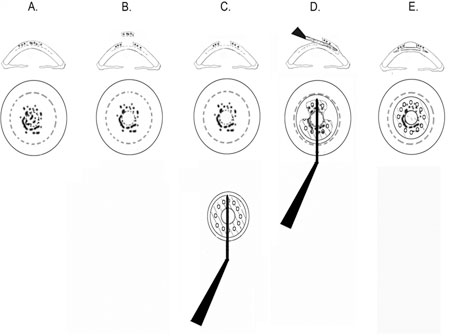
Figure 1. Schematic representation of artificial cornea surgery.
Images: Vargas JM, Shiuey Y
In Figure 1A, the pocket has been created within the layers of the diseased cornea using a femtosecond laser. Dashed lines indicate the pocket. The pocket divides the cornea into anterior and posterior layers. The spots in the anterior layer represent abnormalities such as epithelial edema or corneal scarring. A 3.5-mm trephination incision made with the femtosecond laser is shown in dashed lines in the center of the cornea. In Figure 1B, the central 3.5 mm of diseased anterior cornea has been excised. The edge of the 3.5-mm diameter excision is depicted as a circle in dashed lines. In Figure 1C, a KeraKlear artificial cornea is held by insertion forceps. Figure 1D shows that the KeraKlear has been inserted into the corneal pocket through the 3.5-mm diameter incision. During insertion, the thin and flexible rim of the KeraKlear folds upon itself. Figure 1E shows that the KeraKlear optic fills the space left by the removal of the diseased central 3.5 mm of the cornea. Optionally, the KeraKlear can be sutured in place by passing sutures through the holes of the KeraKlear and through the anterior and posterior layers of the cornea. Importantly, the posterior cornea remains intact, which mitigates the risk of endophthalmitis, expulsive hemorrhage and retroprosthetic membrane formation.
Figures 2 through 5 are intraoperative photographs displaying how the flexible KeraKlear artificial cornea can be placed into the corneal pocket using a blunt spatula and forceps. The rim of the KeraKlear is gently tucked into the pocket recesses using blunt instruments until the entire rim is implanted. Figure 6 shows an example of the corneal appearance before and after implantation of the artificial cornea.
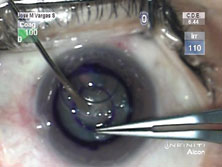
Figure 2. Intraoperative photograph of artificial cornea surgery.

Figure 3. Intracorneal insertion of artificial cornea.
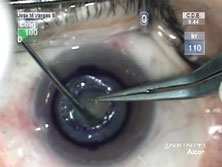
Figure 4. The rim is tucked into the corneal pocket.
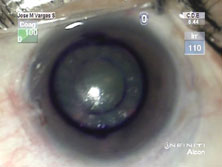
Figure 5. Completed view of the artificial cornea.
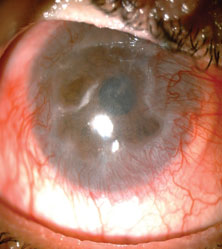
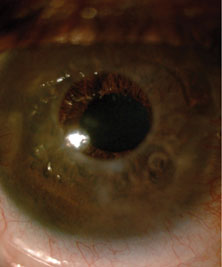
Figure 6. Preop and postop appearance of the cornea following artificial cornea surgery.
Clinical results
Data for 16 KeraKlear patients were presented at the American Society of Cataract and Refractive Surgery meeting in Chicago. All patients had preoperative vision that ranged from 20/200 to hand motions. The preoperative diagnoses included failed grafts, burns, corneal dystrophies, corneal scars, failed RK and keratoconus. Follow-up ranged from 9 to 19 months. Postoperatively, all patients had improvement in vision. Postoperative visual acuity ranged from 20/20 to 20/100, except for one patient with pre-existing retinal pathology who had 20/400 vision. Vision improvement occurred immediately but in some cases continued to improve over several months. There were no significant complications in this series. Specifically, there were no cases of endophthalmitis, device extrusion, retroprosthetic membrane or glaucoma, which are relatively common complications of other types of keratoprostheses.
Advantages
Benefits of the KeraKlear artificial cornea include no need for donor corneal tissue, a nonpenetrating surgery with no entry into the anterior chamber, and the ability to improve vision in a wide variety of corneal conditions. Even in cases of endothelial failure, vision was improved because of the restoration of a smooth anterior optical surface.
In conclusion, the data so far have been encouraging with regard to the feasibility of using the KeraKlear artificial cornea as an alternative to corneal transplantation when tissue is not available or when the prognosis for transplantation is poor.
References:
- Akpek EK, Aldave AJ, Aquavella JV. The use of precut, γ-irradiated corneal lenticules in Boston type 1 keratoprosthesis implantation [published online ahead of print May 25, 2012]. Am J Ophthalmol. doi:10.1016/j.ajo.2012.03.022.
- Aldave AJ, Sangwan VS, Basu S, et al. International results with the Boston type I keratoprosthesis [published online ahead of print April 18, 2012]. Ophthalmology. doi:10.1016/j.ophtha.2012.02.015.
- Kang JJ, de la Cruz J, Cortina MS. Visual outcomes of Boston keratoprosthesis implantation as the primary penetrating corneal procedure [published online ahead of print Feb. 23, 2012]. Cornea. doi:10.1097/ICO.0b013e31823f7765.
For more information:
- Thomas John, MD, is a clinical associate professor at Loyola University at Chicago and is in private practice in Oak Brook, Tinley Park and Oak Lawn, Ill. He can be reached at 708-429-2223; email: tjcornea@gmail.com.
- Yichieh Shiuey, MD, can be reached at 408-752-0850; email: shiuey@yahoo.com.
- Jose M. Vargas, MD, can be reached at 58-241-8246064; email: corneavargas@me.com.
- Disclosures: John has no relevant financial disclosures. Shiuey is the inventor of the KeraKlear and has a financial interest in this device. Vargas is a paid consultant for KeraMed.
